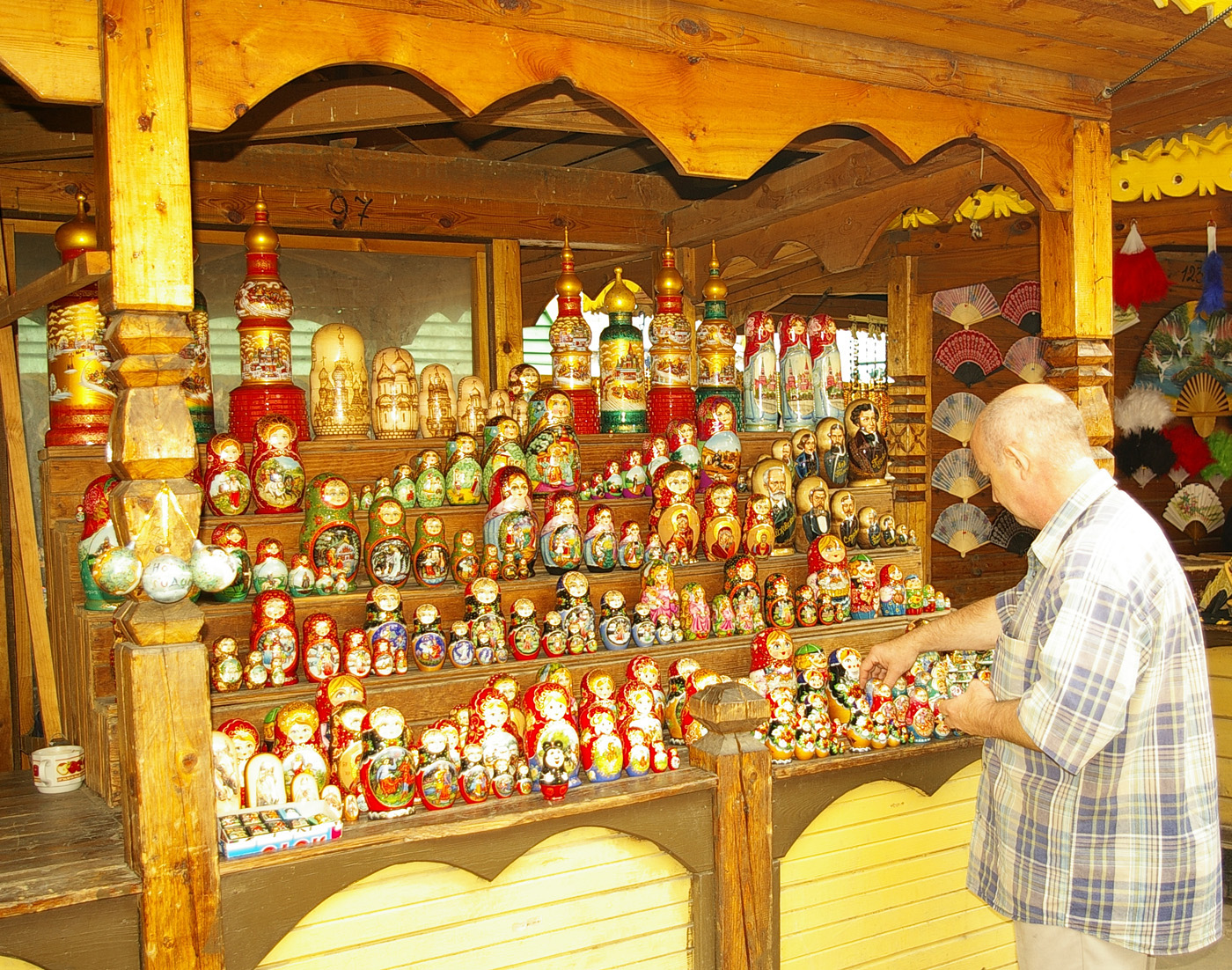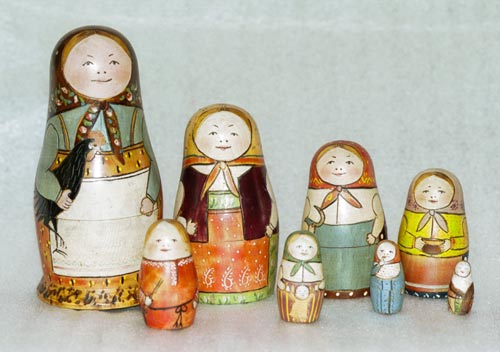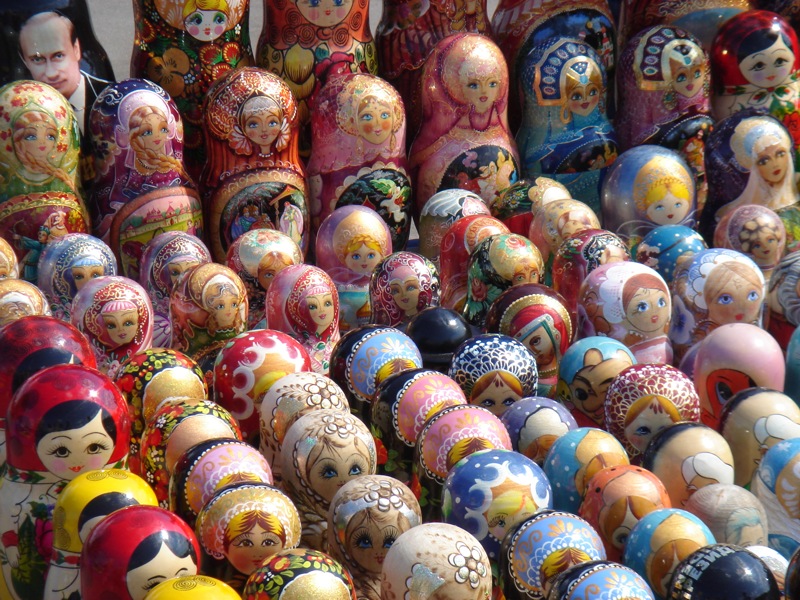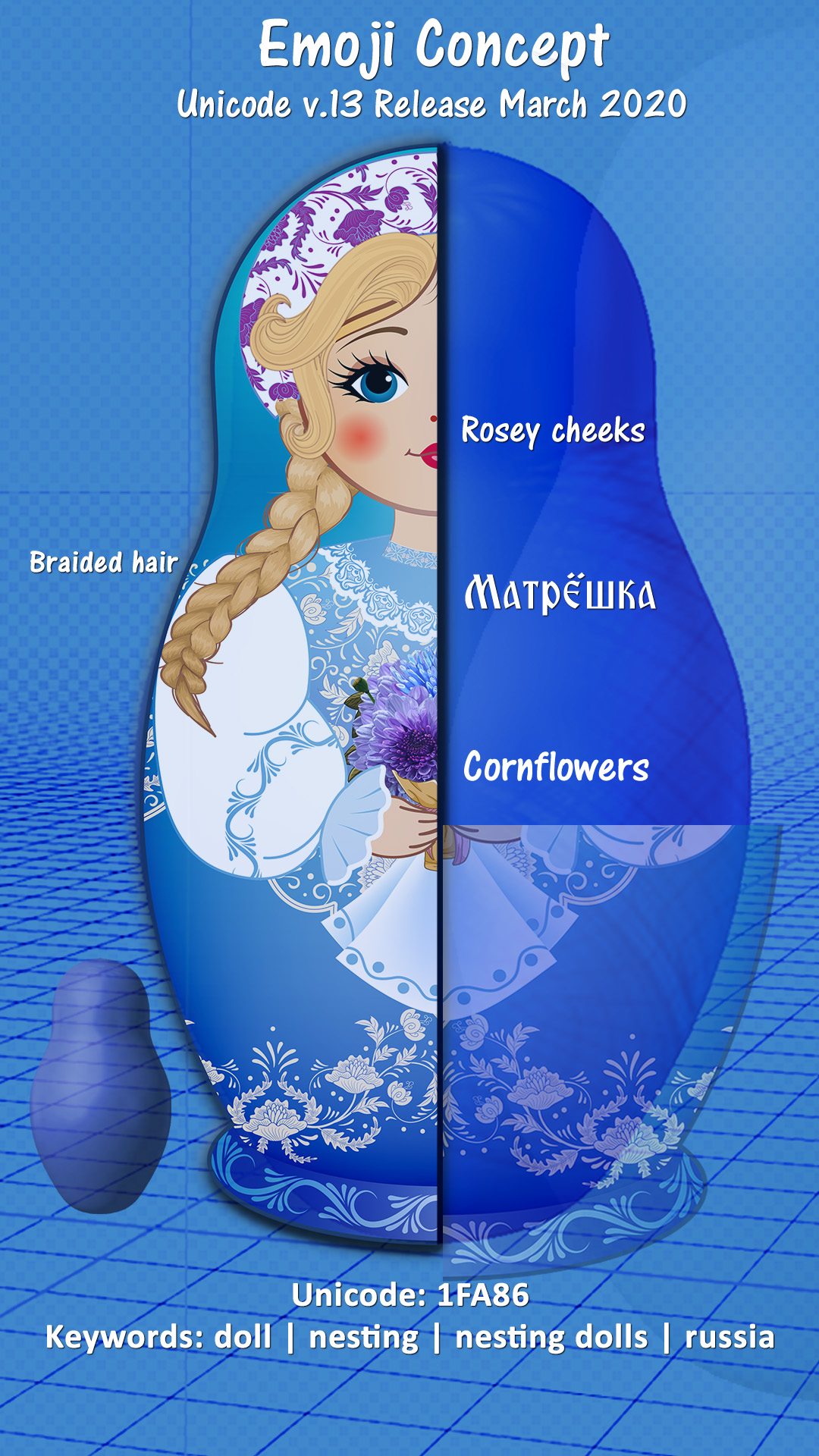Matryoshka doll on:
[Wikipedia]
[Google]
[Amazon]


 Matryoshka dolls ( ; rus, матрёшка, p=mɐˈtrʲɵʂkə, a=Ru-матрёшка.ogg), also known as stacking dolls, nesting dolls, Russian tea dolls, or Russian dolls, are a set of wooden
Matryoshka dolls ( ; rus, матрёшка, p=mɐˈtrʲɵʂkə, a=Ru-матрёшка.ogg), also known as stacking dolls, nesting dolls, Russian tea dolls, or Russian dolls, are a set of wooden
 The first Russian nested doll set was carved in 1890 at the Children's Education Workshop by Vasily Zvyozdochkin and designed by Sergey Malyutin, who was a folk crafts painter in the Abramtsevo estate of Savva Mamontov, a Russian industrialist and patron of arts. Mamontov's brother, Anatoly Ivanovich Mamontov (1839–1905) created the Children's Education Workshop to make and sell children's toys. The doll set was painted by Malyutin. Malyutin's doll set consisted of eight dolls—the outermost was a mother in a traditional dress holding a red-combed
The first Russian nested doll set was carved in 1890 at the Children's Education Workshop by Vasily Zvyozdochkin and designed by Sergey Malyutin, who was a folk crafts painter in the Abramtsevo estate of Savva Mamontov, a Russian industrialist and patron of arts. Mamontov's brother, Anatoly Ivanovich Mamontov (1839–1905) created the Children's Education Workshop to make and sell children's toys. The doll set was painted by Malyutin. Malyutin's doll set consisted of eight dolls—the outermost was a mother in a traditional dress holding a red-combed

 Matryoshka dolls are often designed to follow a particular theme; for instance, peasant girls in traditional dress. Originally, themes were often drawn from tradition or
Matryoshka dolls are often designed to follow a particular theme; for instance, peasant girls in traditional dress. Originally, themes were often drawn from tradition or
 Matryoshka is often seen as a symbol of the feminine side of Russian culture. Matryoshka is associated in Russia with family and fertility. Matryoshka is used as the symbol for the epithet Mother Russia.
Matryoshka dolls are a traditional representation of the mother carrying a child within her and can be seen as a representation of a chain of mothers carrying on the family legacy through the child in their womb. Furthermore, matryoshka dolls are used to illustrate the unity of body, soul, mind, heart, and spirit.
Matryoshkas are also used
Matryoshka is often seen as a symbol of the feminine side of Russian culture. Matryoshka is associated in Russia with family and fertility. Matryoshka is used as the symbol for the epithet Mother Russia.
Matryoshka dolls are a traditional representation of the mother carrying a child within her and can be seen as a representation of a chain of mothers carrying on the family legacy through the child in their womb. Furthermore, matryoshka dolls are used to illustrate the unity of body, soul, mind, heart, and spirit.
Matryoshkas are also used
 In 2020, the
In 2020, the


doll
A doll is a model typically of a human or humanoid character, often used as a toy for children. Dolls have also been used in traditional religious rituals throughout the world. Traditional dolls made of materials such as clay and wood are foun ...
s of decreasing size placed one inside another. The name ''matryoshka'', mainly known as "little matron", is a diminutive
A diminutive is a root word that has been modified to convey a slighter degree of its root meaning, either to convey the smallness of the object or quality named, or to convey a sense of intimacy or endearment. A ( abbreviated ) is a word-form ...
form of ''Matryosha'' (), in turn a diminutive of the Russian female first name ''Matryona'' ().
A set of matryoshkas consists of a wooden figure, which separates at the middle, top from bottom, to reveal a smaller figure of the same sort inside, which has, in turn, another figure inside of it, and so on.
The first Russian nested doll set was made in 1890 by wood turning craftsman and wood carver Vasily Zvyozdochkin from a design by Sergey Malyutin, who was a folk crafts painter at Abramtsevo. Traditionally the outer layer is a woman, dressed in a sarafan
A sarafan ( rus, сарафа́н, p=sərɐˈfan, from fa, سراپا ''sarāpā'', literally " romhead to feet") is a long, trapezoidal Russian jumper dress (pinafore dress) worn by girls and women and forming part of Russian traditional fo ...
, a long and shapeless traditional Russian peasant jumper dress. The figures inside may be of any gender; the smallest, innermost doll is typically a baby turned from a single piece of wood. Much of the artistry is in the painting of each doll, which can be very elaborate. The dolls often follow a theme; the themes may vary, from fairy tale
A fairy tale (alternative names include fairytale, fairy story, magic tale, or wonder tale) is a short story that belongs to the folklore genre. Such stories typically feature magic, enchantments, and mythical or fanciful beings. In most cult ...
characters to Soviet leaders. In the West, matryoshka dolls are often referred to as babushka dolls, though they are not known by this name in Russian; ''babushka'' () means "grandmother" or "old woman".
History
 The first Russian nested doll set was carved in 1890 at the Children's Education Workshop by Vasily Zvyozdochkin and designed by Sergey Malyutin, who was a folk crafts painter in the Abramtsevo estate of Savva Mamontov, a Russian industrialist and patron of arts. Mamontov's brother, Anatoly Ivanovich Mamontov (1839–1905) created the Children's Education Workshop to make and sell children's toys. The doll set was painted by Malyutin. Malyutin's doll set consisted of eight dolls—the outermost was a mother in a traditional dress holding a red-combed
The first Russian nested doll set was carved in 1890 at the Children's Education Workshop by Vasily Zvyozdochkin and designed by Sergey Malyutin, who was a folk crafts painter in the Abramtsevo estate of Savva Mamontov, a Russian industrialist and patron of arts. Mamontov's brother, Anatoly Ivanovich Mamontov (1839–1905) created the Children's Education Workshop to make and sell children's toys. The doll set was painted by Malyutin. Malyutin's doll set consisted of eight dolls—the outermost was a mother in a traditional dress holding a red-combed rooster
The chicken (''Gallus gallus domesticus'') is a domesticated junglefowl species, with attributes of wild species such as the grey and the Ceylon junglefowl that are originally from Southeastern Asia. Rooster or cock is a term for an adult m ...
. The inner dolls were her children, girls and a boy, and the innermost a baby. The Children's Education Workshop was closed in the late 1890s, but the tradition of the matryoshka simply relocated to Sergiyev Posad
Sergiyev Posad ( rus, Се́ргиев Поса́д, p=ˈsʲɛrgʲɪ(j)ɪf pɐˈsat) is a city and the administrative center of Sergiyevo-Posadsky District in Moscow Oblast, Russia. Population:
It was previously known as ''Sergiyev Posad'' (un ...
, the Russian city known as a toy-making center since the fourteenth century.
The inspiration for matryoshka dolls is not clear. It is believed that Zvyozdochkin and Malyutin were inspired by eastern Asian culture, for example, the Honshu doll, named after the main island of Japan
Japan ( ja, 日本, or , and formally , ''Nihonkoku'') is an island country in East Asia. It is situated in the northwest Pacific Ocean, and is bordered on the west by the Sea of Japan, while extending from the Sea of Okhotsk in the n ...
, however, the Honshu figures cannot be placed one inside another. Sources differ in descriptions of the doll, describing it as either a round, hollow daruma doll
A is a hollow, round, Japanese traditional doll modeled after Bodhidharma, the founder of the Zen tradition of Buddhism. These dolls, though typically red and depicting a bearded man (Bodhidharma), vary greatly in color and design depending o ...
, portraying a bald old Buddhist
Buddhism ( , ), also known as Buddha Dharma and Dharmavinaya (), is an Indian religion or philosophical tradition based on teachings attributed to the Buddha. It originated in northern India as a -movement in the 5th century BCE, and ...
monk, or a Seven Lucky Gods
In Japanese mythology, the Seven Lucky Gods or Seven Gods of Fortune (, shichifukujin in Japanese) are believed to grant good luck and are often represented in netsuke and in artworks. One of the seven (Jurōjin) is said to be based on a historic ...
nesting doll.
Savva Mamontov's wife presented the dolls at the Exposition Universelle in Paris in 1900, where the toy earned a bronze medal. Soon after, matryoshka dolls were being made in several places in Russia and shipped around the world.
Manufacture
Ordinarily, matryoshka dolls are crafted from linden wood. There is a popular misconception that they are carved from one piece of wood. Rather, they are produced using: alathe
A lathe () is a machine tool that rotates a workpiece about an axis of rotation to perform various operations such as cutting, sanding, knurling, drilling, deformation, facing, and turning, with tools that are applied to the workpiece ...
equipped with a balance bar
Balance Bar, sometimes styled as balance bar, is the brand name of a nutritional energy bar based on the 40-30-30 dietary principle, that is, a diet containing 40% carbohydrate, 30% protein and 30% dietary fat. The 40-30-30 nutritional philosophy w ...
; four heavy long distinct types of chisel
A chisel is a tool with a characteristically shaped cutting edge (such that wood chisels have lent part of their name to a particular grind) of blade on its end, for carving or cutting a hard material such as wood, stone, or metal by hand, s ...
s (hook, knife, pipe, and spoon); and a "set of handmade wooden calipers particular to a size of the doll". The tools are hand forged by a village blacksmith
A blacksmith is a metalsmith who creates objects primarily from wrought iron or steel, but sometimes from other metals, by forging the metal, using tools to hammer, bend, and cut (cf. tinsmith). Blacksmiths produce objects such as gates, gr ...
from car axles or other salvage. A wood carver uniquely crafts each set of wooden calipers. Multiple pieces of wood are meticulously carved into the nesting set.
Themes in dolls
 Matryoshka dolls are often designed to follow a particular theme; for instance, peasant girls in traditional dress. Originally, themes were often drawn from tradition or
Matryoshka dolls are often designed to follow a particular theme; for instance, peasant girls in traditional dress. Originally, themes were often drawn from tradition or fairy tale
A fairy tale (alternative names include fairytale, fairy story, magic tale, or wonder tale) is a short story that belongs to the folklore genre. Such stories typically feature magic, enchantments, and mythical or fanciful beings. In most cult ...
characters, in keeping with the craft tradition—but since the late 20th century, they have embraced a larger range, including Russian leaders.
Common themes of matryoshkas are floral and relate to nature. Often Christmas, Easter, and religion are used as themes for the doll. Modern artists create many new styles of nesting dolls, mostly as an alternative purchase option for tourism. These include animal collections, portraits, and caricatures of famous politicians, musicians, athletes, astronauts, "robots", and popular movie stars. Today, some Russian artists specialize in painting themed matryoshka dolls that feature specific categories of subjects, people or nature. Areas with notable matryoshka styles include Sergiyev Posad
Sergiyev Posad ( rus, Се́ргиев Поса́д, p=ˈsʲɛrgʲɪ(j)ɪf pɐˈsat) is a city and the administrative center of Sergiyevo-Posadsky District in Moscow Oblast, Russia. Population:
It was previously known as ''Sergiyev Posad'' (un ...
, Semionovo (now the town of Semyonov), Polkhovsky Maidan, and the city of Kirov.
Political matryoshkas
In the late 1980s and early 1990s duringPerestroika
''Perestroika'' (; russian: links=no, перестройка, p=pʲɪrʲɪˈstrojkə, a=ru-perestroika.ogg) was a political movement for reform within the Communist Party of the Soviet Union (CPSU) during the late 1980s widely associated wit ...
, freedom of expression allowed the leaders of the Soviet Union
During its 69-year history, the Soviet Union usually had a ''de facto'' leader who would not necessarily be head of state but would lead while holding an office such as premier or general secretary. Under the 1977 Constitution, the chairman of ...
to become a common theme of the matryoshka, with the largest doll featuring then-current leader Mikhail Gorbachev
Mikhail Sergeyevich Gorbachev (2 March 1931 – 30 August 2022) was a Soviet politician who served as the 8th and final leader of the Soviet Union from 1985 to the country's dissolution in 1991. He served as General Secretary of the Com ...
. These became very popular at the time, affectionately earning the nickname of a ''Gorba'' or ''Gorby'', the namesake of Gorbachev. With the periodic succession of Russian leadership after the collapse of the Soviet Union
The dissolution of the Soviet Union, also negatively connoted as rus, Разва́л Сове́тского Сою́за, r=Razvál Sovétskogo Soyúza, ''Ruining of the Soviet Union''. was the process of internal disintegration within the Sov ...
, newer versions would start to feature Russian presidents Boris Yeltsin
Boris Nikolayevich Yeltsin ( rus, Борис Николаевич Ельцин, p=bɐˈrʲis nʲɪkɐˈla(j)ɪvʲɪtɕ ˈjelʲtsɨn, a=Ru-Boris Nikolayevich Yeltsin.ogg; 1 February 1931 – 23 April 2007) was a Soviet and Russian politician wh ...
, Vladimir Putin
Vladimir Vladimirovich Putin; (born 7 October 1952) is a Russian politician and former intelligence officer who holds the office of president of Russia. Putin has served continuously as president or prime minister since 1999: as prime min ...
, and Dmitry Medvedev
Dmitry Anatolyevich Medvedev ( rus, links=no, Дмитрий Анатольевич Медведев, p=ˈdmʲitrʲɪj ɐnɐˈtolʲjɪvʲɪtɕ mʲɪdˈvʲedʲɪf; born 14 September 1965) is a Russian politician who has been serving as the dep ...
.
Most sets feature the current leader as the largest doll, with the predecessors decreasing in size. The remaining smaller dolls may feature other former leaders such as Leonid Brezhnev
Leonid Ilyich Brezhnev; uk, links= no, Леонід Ілліч Брежнєв, . (19 December 1906– 10 November 1982) was a Soviet politician who served as General Secretary of the Communist Party of the Soviet Union between 1964 and 1 ...
, Nikita Khrushchev
Nikita Sergeyevich Khrushchev (– 11 September 1971) was the First Secretary of the Communist Party of the Soviet Union from 1953 to 1964 and chairman of the country's Council of Ministers from 1958 to 1964. During his rule, Khrushchev s ...
, Joseph Stalin
Joseph Vissarionovich Stalin (born Ioseb Besarionis dze Jughashvili; – 5 March 1953) was a Georgian revolutionary and Soviet Union, Soviet political leader who led the Soviet Union from 1924 until his death in 1953. He held power as Ge ...
, Vladimir Lenin
Vladimir Ilyich Ulyanov. ( 1870 – 21 January 1924), better known as Vladimir Lenin,. was a Russian revolutionary, politician, and political theorist. He served as the first and founding head of government of Soviet Russia from 1917 to 1 ...
, and sometimes several historically significant Tsars
Tsar ( or ), also spelled ''czar'', ''tzar'', or ''csar'', is a title used by East and South Slavic monarchs. The term is derived from the Latin word ''caesar'', which was intended to mean "emperor" in the European medieval sense of the ter ...
such as Nicholas II
Nicholas II or Nikolai II Alexandrovich Romanov; spelled in pre-revolutionary script. ( 186817 July 1918), known in the Russian Orthodox Church as Saint Nicholas the Passion-Bearer,. was the last Emperor of Russia, King of Congress Pol ...
and Peter the Great
Peter I ( – ), most commonly known as Peter the Great,) or Pyotr Alekséyevich ( rus, Пётр Алексе́евич, p=ˈpʲɵtr ɐlʲɪˈksʲejɪvʲɪtɕ, , group=pron was a Russian monarch who ruled the Tsardom of Russia from t ...
. Yuri Andropov
Yuri Vladimirovich Andropov (– 9 February 1984) was the sixth paramount leader of the Soviet Union and the fourth General Secretary of the Communist Party of the Soviet Union. After Leonid Brezhnev's 18-year rule, Andropov served in the ...
and Konstantin Chernenko
Konstantin Ustinovich Chernenko uk, Костянтин Устинович Черненко, translit=Kostiantyn Ustynovych Chernenko (24 September 1911 – 10 March 1985) was a Soviet politician and the seventh General Secretary of the Commu ...
rarely appear due to the short length of their respective terms. Some less-common sets may feature the current leader as the smallest doll, with the predecessors increasing in size, usually with Stalin or Lenin as the largest doll.
Some sets that include Yeltsin preceding Gorbachev were made during the brief period between the establishment of President of the RSFSR and the collapse of the Soviet Union, as both Yeltsin and Gorbachev were concurrently in prominent government positions. During Medvedev's presidency, Medvedev and Putin may both share the largest doll due to Putin still having a prominent role in the government as Prime Minister of Russia
The chairman of the government of the Russian Federation, also informally known as the prime minister, is the nominal head of government of Russia. Although the post dates back to 1905, its current form was established on 12 December 1993 fo ...
. As of Putin's re-election as the fourth President of Russia, Medvedev will usually succeed Yeltsin and preceded Putin in stacking order, due to Putin's role solely as the largest doll.
Political matryoshkas usually range between five and ten dolls per set.
World record
The largest set of matryoshka dolls in the world is a 51-piece set hand-painted by Youlia Bereznitskaia of Russia, completed in 2003. The tallest doll in the set measures ; the smallest, . Arranged side-by-side, the dolls span .As metaphor
 Matryoshka is often seen as a symbol of the feminine side of Russian culture. Matryoshka is associated in Russia with family and fertility. Matryoshka is used as the symbol for the epithet Mother Russia.
Matryoshka dolls are a traditional representation of the mother carrying a child within her and can be seen as a representation of a chain of mothers carrying on the family legacy through the child in their womb. Furthermore, matryoshka dolls are used to illustrate the unity of body, soul, mind, heart, and spirit.
Matryoshkas are also used
Matryoshka is often seen as a symbol of the feminine side of Russian culture. Matryoshka is associated in Russia with family and fertility. Matryoshka is used as the symbol for the epithet Mother Russia.
Matryoshka dolls are a traditional representation of the mother carrying a child within her and can be seen as a representation of a chain of mothers carrying on the family legacy through the child in their womb. Furthermore, matryoshka dolls are used to illustrate the unity of body, soul, mind, heart, and spirit.
Matryoshkas are also used metaphor
A metaphor is a figure of speech that, for rhetorical effect, directly refers to one thing by mentioning another. It may provide (or obscure) clarity or identify hidden similarities between two different ideas. Metaphors are often compared wi ...
ically, as a design paradigm
A design is a plan or specification for the construction of an object or system or for the implementation of an activity or process or the result of that plan or specification in the form of a prototype, product, or process. The verb ''to design' ...
, known as the "matryoshka principle" or "nested doll principle". It denotes a recognizable relationship of "object-within-similar-object" that appears in the design of many other natural and crafted objects. Examples of this use include the matrioshka brain, the Matroska media-container format, and the Russian Doll model of multi-walled carbon nanotubes.
The onion metaphor is similar. If the outer layer is peeled off an onion, a similar onion exists within. This structure is employed by designers in applications such as the layering of clothes or the design of tables, where a smaller table nests within a larger table, and a smaller one within that.
The metaphor of the matryoshka doll (or its onion equivalent) is also used in the description of shell companies and similar corporate structures that are used in the context of tax-evasion schemes in low-tax jurisdictions (for example, offshore tax havens). It has also been used to describe satellites
A satellite or artificial satellite is an object intentionally placed into orbit in outer space. Except for passive satellites, most satellites have an electricity generation system for equipment on board, such as solar panels or radioisotop ...
and suspected weapons in space.
As an emoji
 In 2020, the
In 2020, the Unicode Consortium
The Unicode Consortium (legally Unicode, Inc.) is a 501(c)(3) non-profit organization incorporated and based in Mountain View, California. Its primary purpose is to maintain and publish the Unicode Standard which was developed with the intentio ...
approved the matryoshka doll (🪆) as one of the new emoji
An emoji ( ; plural emoji or emojis) is a pictogram, logogram, ideogram or smiley embedded in text and used in electronic messages and web pages. The primary function of emoji is to fill in emotional cues otherwise missing from typed conv ...
characters in release v.13. The matryoshka or nesting doll emoji was presented to the consortium by Jef Gray, as a non-religious, apolitical symbol of Russian-East European-Far East Asian culture.
See also
*Amish doll
Amish dolls are a type of rag doll and a popular form of American folk art, which originated as children's toys among the Old Order Amish people. While some Amish dolls have faces, the best-known ones do not, to emphasize the fact that all are a ...
* Chinese boxes
* Daruma doll
A is a hollow, round, Japanese traditional doll modeled after Bodhidharma, the founder of the Zen tradition of Buddhism. These dolls, though typically red and depicting a bearded man (Bodhidharma), vary greatly in color and design depending o ...
* Droste effect
The Droste effect (), known in art as an example of '' mise en abyme'', is the effect of a picture recursively appearing within itself, in a place where a similar picture would realistically be expected to appear. This produces a loop which i ...
* Fractal
In mathematics, a fractal is a geometric shape containing detailed structure at arbitrarily small scales, usually having a fractal dimension strictly exceeding the topological dimension. Many fractals appear similar at various scales, as ill ...
*
* Mise en abyme
In Western art history, ''mise en abyme'' (; also ''mise en abîme'') is a formal technique of placing a copy of an image within itself, often in a way that suggests an infinitely recurring sequence. In film theory and literary theory, it refers ...
* Recursion
Recursion (adjective: ''recursive'') occurs when a thing is defined in terms of itself or of its type. Recursion is used in a variety of disciplines ranging from linguistics to logic. The most common application of recursion is in mathematic ...
* Russian culture
Russian culture (russian: Культура России, Kul'tura Rossii) has been formed by the nation's history, its geographical location and its vast expanse, religious and social traditions, and Western influence. Russian writers and ph ...
* Self-similarity
__NOTOC__
In mathematics, a self-similar object is exactly or approximately similar to a part of itself (i.e., the whole has the same shape as one or more of the parts). Many objects in the real world, such as coastlines, are statistically se ...
* Shaker-style pantry box
* ''Stacking'' (video game)
* Turducken
* Turtles all the way down
References
External links
* {{Authority control 1890s toys Armenian culture Containers Culture of Georgia (country) Handicrafts Nested containers Products introduced in 1890 Russian culture Russian inventions Soviet culture Traditional dolls Ukrainian culture Wooden dolls 1890 establishments in the Russian Empire